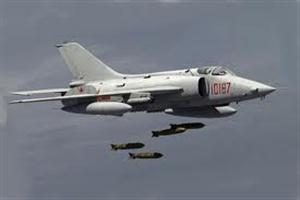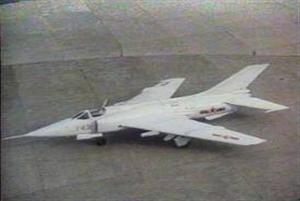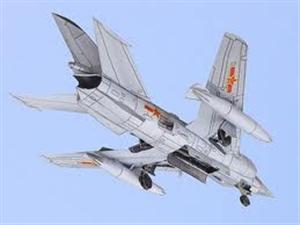Nanchang Q-5
The story of Nanchang Q-5 began in 1955 when China clashed with Taiwan in armed conflict for the Yijang-Shan Island – and captured the latter. Although the PLAAF’s Ilyushin IL-10M ground attack aircraft (NATO reporting name Bark) flying close air support (CAS) missions for the Chinese marines coped with their task, it was clear that a jet attack aircraft with supersonic performance was needed urgently.
The Shenyang aircraft factory presented a preliminary design concept in early 1958; incidentally, the students of the Shenyang Aviation Institute had a hand in the design process. In August of the same year Wang Xiping, Director of the Aviation Industry Bureau, and his deputy Xu Changyi decided that development of the attack aircraft should be undertaken by the Nanchang factory (which had by then gained some experience with jets). Development of this aircraft initially designated XionYing-302 (Mighty Eagle-302) but soon renamed Q-5 (Qiangjiji – attack aircraft) began in August 1958 under the supervision of Lu Xiaopeng, the factory’s Vice Director, A team of ten Nanchang factory engineers, including Vice Chief Engineer Feng Xu and section director Gao Zhenning, was sent to Shenyang to work on the general layout.
 Building on the PLAAF’s operational requirements and attack aircraft development trends, the engineers at Nanchang believed the future aircraft’s main role would be CAS. To this end the fighter-bomber needed good low-altitude performance and plenty of firepower, as well as some potential as a dogfighter for self-defence, good field performance and adequate range and endurance.
Building on the PLAAF’s operational requirements and attack aircraft development trends, the engineers at Nanchang believed the future aircraft’s main role would be CAS. To this end the fighter-bomber needed good low-altitude performance and plenty of firepower, as well as some potential as a dogfighter for self-defence, good field performance and adequate range and endurance.
Despite the demand for maximum structural commonality with the original J-6, the Nanchang Q-5 was virtually a new airframe. The fuselage was completely redesigned and some 25% longer, with new forward and centre sections; only the aft fuselage remained relatively unchanged. The bifurcated nose air intake gave place to a long pointed nose giving a better view downward; the nose housed avionics, with a view to possibly installing a radar later on. The engines now breathed through oval-section lateral intakes flanking the cockpit, with short boundary layer splitter plates. This more draggy arrangement, coupled with the higher gross weight, reduced the Q-5’s top speed substantially (by Mach 0.23), as it turned out. The canopy was much shorter and aft-hinged, not sliding. The cockpit featured armour protection against small- arms fire.
 The centre fuselage was area-ruled to cut transonic drag and incorporated a small internal weapons bay about 4 m (13 ft 1 in) long which was the real reason for this extensive redesign. This could accommodate, e.g., four 250-kg (551-lb) HE bombs or a single 5- to 20- kiloton nuclear bomb and was flanked by bomb racks for carrying two more bombs; the maximum ordnance load was specified at 2,000 kg (4,409 lb). A large ventral airbrake was located ahead of the weapons bay and the twin lateral airbrakes on the aft fuselage were relocated. The single ventral fin of the MiG-19 gave way to outward-canted twin strakes.
The centre fuselage was area-ruled to cut transonic drag and incorporated a small internal weapons bay about 4 m (13 ft 1 in) long which was the real reason for this extensive redesign. This could accommodate, e.g., four 250-kg (551-lb) HE bombs or a single 5- to 20- kiloton nuclear bomb and was flanked by bomb racks for carrying two more bombs; the maximum ordnance load was specified at 2,000 kg (4,409 lb). A large ventral airbrake was located ahead of the weapons bay and the twin lateral airbrakes on the aft fuselage were relocated. The single ventral fin of the MiG-19 gave way to outward-canted twin strakes.
The wings were superficially similar to those of the MiG-19 Farmer but swept back 52°30′ at quarter-chord instead of 55° to improve lift at low speed (and hence turning characteristics), featuring increased area. Gouge flaps and no roll control spoilers. The trailing edge was kinked, being at right angles to the fuselage on the inboard portions. The horizontal tail remained unchanged but vertical tail height and area was increased to offset the greater area ahead of the CG. There was a smooth transition from fin to fuselage – the MiG-19’s pronounced fin fillet was gone.
To make the most of the available space in the forward avionics bay the forward-retracting nose gear unit was redesigned so that the wheel rotated through 87° during retraction to lie flat in the nosewheel well which was slightly offset to port. The main gear units had fat low-pressure tyres. The Nanchang Q-5 retained the MiG-19’s (J-6’s) powerplant – two 3,250-kgp (7,165-lbst) Shenyang WP-6 afterburning turbojets – and the numerous cooling air scoops on the aft fuselage. The five fuel tanks (three in the centre fuselage and two in the rear fuselage) held 3,648 litres (802.5 Imp gal); provisions were made for carrying 760-litre (167.2 Imp gal) drop tanks inboard and 400-litre or (88 Imp gal) drop tanks outboard.
 The built-in armament consisted of two Type 23-2K cannons with 100 rpg in the fuselage nose. This simplified reloading but was the worst possible location from an operational standpoint, since the gun blast gases were guaranteed to be ingested by the engines, causing surge. An SH-1 optical gun- sight was fitted.
The built-in armament consisted of two Type 23-2K cannons with 100 rpg in the fuselage nose. This simplified reloading but was the worst possible location from an operational standpoint, since the gun blast gases were guaranteed to be ingested by the engines, causing surge. An SH-1 optical gun- sight was fitted.
The unserialled first prototype Q-5 (c/n 02) took to the air on 4th June 1965 with test pilot Tuo Fenming at the controls. A provisional type certificate was awarded same year after only 25 hours of flight tests. On 10th March 1966 the aircraft was demonstrated to Ye Jianying, Vice Chairman of the Military Commission of the Central Committee of the Communist Party. The big shot was very impressed.

Comments are closed, but trackbacks and pingbacks are open.